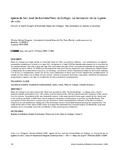Mostrar o rexistro simple do ítem
Iglesia de San José de Anchieta-Pateo do Collegio: la renovación de los lugares de culto
| dc.contributor.author | Seegerer, Christian Michael | |
| dc.date.accessioned | 2020-10-02T12:45:09Z | |
| dc.date.available | 2020-10-02T12:45:09Z | |
| dc.date.issued | 2020 | |
| dc.identifier.citation | Seegerer, Christian Michael. 2020. «Iglesia de San José de Anchieta-Pateo do Collegio. La renovación de los lugares de culto». Actas de Arquitectura Religiosa Contemporánea 7: 100-111. https://doi.org/10.17979/aarc.2020.7.0.6294 | es_ES |
| dc.identifier.issn | 2659-8671 | |
| dc.identifier.uri | http://hdl.handle.net/2183/26305 | |
| dc.description.abstract | [Resumen] Pateo do Collegio es el lugar donde se fundó São Paulo en 1554. Los primeros edificios —una universidad y una iglesia— presentaban arquitectura colonial en el siglo XVII, y la iglesia en el siglo XVIII fue abandonada después de la expulsión de los jesuitas del país. Demolido a fines del siglo XIX, a principios del siglo XX fue nuevamente propiedad de los jesuitas y se construyó un nuevo edificio. En 2009 hubo una importante renovación de sus lugares de culto, realizada por Claudio Pastro. La disposición de los elementos es inusual y, sin embargo, conveniente. Pastro materializó la influencia del Concilio Vaticano II en el arte y la arquitectura, siendo una de las voces autorizadas en Brasil que fomentó experiencias paradigmáticas. El estudio de esta reforma es el objeto de este artículo: analizar el proyecto elaborado y ejecutado, identificar las soluciones proyectuales y registrar con rigor la contribución de esta arquitectura contemporánea. | es_ES |
| dc.description.abstract | [Abstract] Pateo do Collegio is the place where São Paulo was founded in 1554. The first buildings —a college and a church— featured colonial architecture in the 17th century, and the church in the 18th was abandoned after expulsion of the Jesuits from the country. Demolished in the late nineteenth century, in the early twentieth it was again owned by the Jesuits and a new building was built. In 2009 there was an important renovation of their places of worship, by Claudio Pastro. The arrangement of the elements is unusual and yet convenient. Pastro materialized the influence of the Second Vatican Council on art and architecture, being one of the authorized voices in Brazil that fostered paradigmatic experiences. The study of this reform is the object of this article: to analyze the elaborated and executed project, to identify the projectual solutions and to accurately record the contribution of this contemporary architecture. | es_ES |
| dc.language.iso | spa | es_ES |
| dc.publisher | Universidade da Coruña | es_ES |
| dc.relation.uri | https://doi.org/10.17979/aarc.2020.7.0.6294 | es_ES |
| dc.rights | Atribución-NoComercial-CompartirIgual 4.0 España | es_ES |
| dc.rights.uri | http://creativecommons.org/licenses/by-nc-sa/4.0/es/ | * |
| dc.subject | Arquitectura brasileña | es_ES |
| dc.subject | Arquitectura contemporánea | es_ES |
| dc.subject | Teoría y crítica | es_ES |
| dc.subject | Pateo do Collegio | es_ES |
| dc.subject | Concilio Vaticano II | es_ES |
| dc.subject | Brazilian Architecture | es_ES |
| dc.subject | Modern Architecture | es_ES |
| dc.subject | Theory and critic | es_ES |
| dc.subject | Vatican II | es_ES |
| dc.title | Iglesia de San José de Anchieta-Pateo do Collegio: la renovación de los lugares de culto | es_ES |
| dc.title.alternative | Church of Saint Joseph of Anchieta-Pateo do Collegio: the Renovation of Places of Worship | es_ES |
| dc.type | info:eu-repo/semantics/article | es_ES |
| dc.rights.access | info:eu-repo/semantics/openAccess | es_ES |
| UDC.journalTitle | Actas de Arquitectura Religiosa Contemporánea | es_ES |
| UDC.volume | 7 | es_ES |
| UDC.startPage | 100 | es_ES |
| UDC.endPage | 111 | es_ES |






